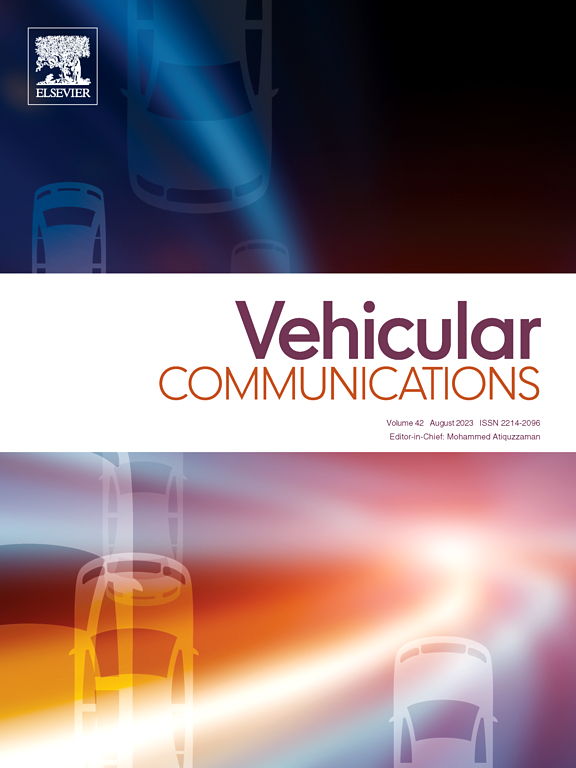Millimeter-wave vehicular collaborative communication assisted by intelligent reflecting surface
IF 6.5
2区 计算机科学
Q1 TELECOMMUNICATIONS
引用次数: 0
Abstract
The combination of the intelligent reflecting surface (IRS) with reconfigurable wireless propagation environment and the millimeter-wave (mmWave) with abundant bandwidth resources can play a great advantage over the rate and delay in vehicular communications. Considering the problem of non-line-of-sight (NLOS) communication between the requesting nodes (RNs) and the service nodes (SNs) in the mmWave vehicular system in this paper, we propose an IRS-assisted multi-hop vehicle-to-vehicle (V2V) cooperative communication method to realize low-delay vehicular communication. Aiming to minimize the communication delay of RNs, an optimization problem is formulated by optimizing the link selection and reflection coefficient matrix of IRS. To tackle the optimization problem, an alternate optimization algorithm is proposed to decompose the original optimization problem into two subproblems for iterative optimization. First, we establish a link selection mechanism based on link quality and vehicle distance and propose a link selection algorithm based on the evaluation function to select communication links for each RN. Then, in particular, we derive the closed-form expression based on successive convex approximation (SCA) techniques for updating the reflection coefficient matrix of IRS. The simulation results show that the IRS-assisted mmWave vehicular cooperative communication scheme proposed in this paper can effectively reduce the communication delay and improve the performance of the mmWave vehicular network.
智能反射面辅助毫米波车辆协同通信
具有可重构无线传播环境的智能反射面(IRS)与带宽资源丰富的毫米波(mmWave)相结合,可以在车载通信中发挥巨大的速率和时延优势。针对毫米波车载系统中请求节点(RNs)与服务节点(SNs)之间的非视距(NLOS)通信问题,提出了一种irs辅助的多跳车对车(V2V)协同通信方法,以实现车载低时延通信。以最小化RNs的通信延迟为目标,通过优化IRS的链路选择和反射系数矩阵,构造了一个优化问题。为了解决优化问题,提出了一种备选优化算法,将原优化问题分解为两个子问题进行迭代优化。首先,我们建立了基于链路质量和车辆距离的链路选择机制,并提出了基于评价函数的链路选择算法,为每个RN选择通信链路。然后,我们特别推导了基于连续凸逼近(SCA)技术的闭式表达式,用于更新IRS反射系数矩阵。仿真结果表明,本文提出的irs辅助毫米波车载协同通信方案能够有效降低通信时延,提高毫米波车载网络的性能。
本文章由计算机程序翻译,如有差异,请以英文原文为准。
求助全文
约1分钟内获得全文
求助全文
来源期刊

Vehicular Communications
Engineering-Electrical and Electronic Engineering
CiteScore
12.70
自引率
10.40%
发文量
88
审稿时长
62 days
期刊介绍:
Vehicular communications is a growing area of communications between vehicles and including roadside communication infrastructure. Advances in wireless communications are making possible sharing of information through real time communications between vehicles and infrastructure. This has led to applications to increase safety of vehicles and communication between passengers and the Internet. Standardization efforts on vehicular communication are also underway to make vehicular transportation safer, greener and easier.
The aim of the journal is to publish high quality peer–reviewed papers in the area of vehicular communications. The scope encompasses all types of communications involving vehicles, including vehicle–to–vehicle and vehicle–to–infrastructure. The scope includes (but not limited to) the following topics related to vehicular communications:
Vehicle to vehicle and vehicle to infrastructure communications
Channel modelling, modulating and coding
Congestion Control and scalability issues
Protocol design, testing and verification
Routing in vehicular networks
Security issues and countermeasures
Deployment and field testing
Reducing energy consumption and enhancing safety of vehicles
Wireless in–car networks
Data collection and dissemination methods
Mobility and handover issues
Safety and driver assistance applications
UAV
Underwater communications
Autonomous cooperative driving
Social networks
Internet of vehicles
Standardization of protocols.
 求助内容:
求助内容: 应助结果提醒方式:
应助结果提醒方式:


